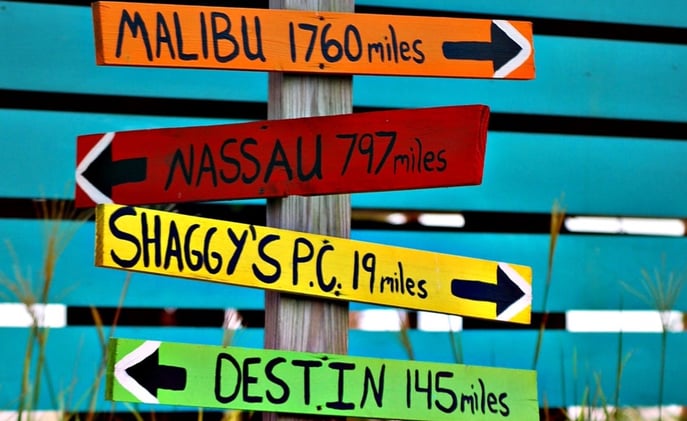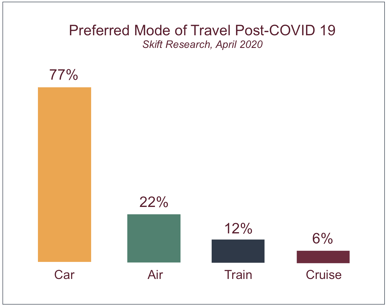Destination marketing: meeting the rising demand for leisure travel
June 1, 2020

As the COVID-19 lockdown has unfolded, pent-up demand among American consumers has begun to reveal itself. And nowhere is that demand greater than in the leisure travel space.
Consider this: A new Harris poll found that for over half of all Americans, travel is number one on their list of major purchases when things return to normal. Further, this demand is most prevalent in families led by parents in the 35-49 age group, with household incomes of $75k or more. If that sounds like the visitors you seek to bring in each year, read on.
In what could be great news for domestic destinations, multiple studies point to those travelers heavily favoring over-the-road travel. No surprise there. With all the negative press associated with flying, and inconsistent responses from the airlines as the pandemic unfolded, much of the traveling public is still leery of travel by air.

So, we know they're going to travel, and likely by road. But where? Indicators, such as a recent report from Skift, show great preference for non-urban beach and rural destinations. This may be attributed to a combination of health concerns and a desire to make up for those postponed Spring Break trips to the mountains and the coast. The same study also shows potential travelers with strong preferences towards rentals and independent accommodations over chain hotels—lodging they perceive as either more self-contained, easier to keep clean, or more flexible should their travel plans change again.
This all adds up to good news for drive destinations–especially those that allow for some continued measure of social distancing. But are destination marketers as ready as the traveling public to re-engage?
In a separate Skift study, it was reported that almost all destinations deserve high marks for altering their marketing campaigns during the lockdown. But it’s a different story when it come to what happens next. Indeed, as of May, only about half of all destinations had even begun planning for outreach in the months ahead. Many destinations, it seems, are unsure of what to do next. Potential visitors, meanwhile, have already begun researching and planning their next trips, with more than half intending to hit the road within the next six months.
The pent-up demand for leisure travel is real, and certain destinations could see a real surge in visitations in the coming months. So how can destination marketers make the most of it as they seek to recover from the spring lockdown? And how can they do so at a time when marketing budgets have likely been cut?
Here are four steps we believe destination marketers can take to begin attracting visitors eager for a safe, rewarding travel experience:
1. Put transparency first.
As potential visitors plan their next trips, their excitement for travel is mixed with lingering health concerns. Destinations that appear indifferent to these feelings stand to lose tremendous potential business from people who want to visit, but also want to know you're taking their safety seriously.
If there’s an official destination response to COVID-19, make it easily accessible for all to see. Include a link on your DMO homepage, and promote it to your entire email list. And make sure hoteliers, restaurants, and attractions are all on board. The information should be comprehensive but not overwhelming, letting people know just what to expect in the places where they're most likely to spend time and money. The more they feel you’re taking a proactive stance, the more comfortable they’ll be vacationing with you.
Ask yourself: what are the most important questions to answer for visitors as we seek to give them the confidence they need to choose our destination?
2. Prioritize loyalists.
That open and transparent approach should be felt above all else by your loyal repeat visitors. This is your chance to make this critical audience feel wanted and welcome. So reach out to them as directly as possible, letting them know you're open for fun and that it just wouldn’t be the same without them. Make sure they know that the great experiences they’ve come to know and love are still there waiting for them. Not only are your core loyalists vital to your business, they often serve as your best advocates for getting the word out to a wider audience.
Ask yourself: what can we do to make our destination as appealing as possible to the visitors who know us best?
And speaking of wider audiences…
3. Cast a wider net.
Just as demand for drive destinations is on the rise, it’s falling for air travel to spots both within and outside of the country. What's more, 65% of travelers in a just released report from Mintel stated they will not consider travel to any one-time COVID hotspots. Less frequented destinations can be the solution for those potential visitors who are rethinking how they want to vacation during uncertain times.
As we mentioned earlier, travel intentions seem to be highest among people with incomes of $75k and more, and according to Ipsos, that extends right up to more affluent travelers. Indeed, this is the number one target audience when it comes to pent-up demand for leisure travel today. And just like everyone else, they're gravitating towards destinations they deem safe for travel at this unique time.
Make sure that your more upscale accommodations are well represented in any communications. Affluent travelers will be looking for seclusion and self-sufficiency as well as luxury, and will be happy to pay for any services that add to this mix of demands.
Many other potential visitors have chosen to travel this year by RV, with rentals and sales soaring in recent months. This represents a reliable audience of travelers who will be on the road looking for great destinations and experiences. RV travelers may not book lodging, but they're just as willing as anyone to shop and dine while visiting a destination. And since they tend to stay longer in places where they feel welcome, they can often mean even more to the local economy.
Ask yourself: How can we reach the widest possible audience of potential visitors who may be traveling differently in 2020?
4. Showcase family friendly (and uncrowded) experiences.
Parents of young children will have two big concerns as they plan their travel: how to keep the kids safe, and how to keep them busy. You can provide the answers to both.
Again, this is where clear, upfront messaging about your destination's COVID-19 response comes into play. We know that moms do their homework, and if they don't find what they're looking for from you, they'll quickly look elsewhere. You might even consider launching a travel hotline or online chat feature that potential visitors can use to ask direct questions about what to expect at your destination.
Of course, the peace of mind you provide will only go so far if they don't see the potential for plenty of family fun as well. Be sure to show parents how they can pack the day full of experiences that the family will love and will leave the kids ready for a great night's sleep.
Ask yourself: how can we strike the right balance between the top two concerns on the minds of parents traveling today: safety and fun?
As unsettled as the recent times have felt in the travel sector, you can be sure that the demand for leisure travel is very real. All across America, families are planning for their first foray away from home since the lockdown began. Those destination marketers who move quickly to engage them and respond to their concerns should be in for a busy, and profitable, travel season in the months ahead.



